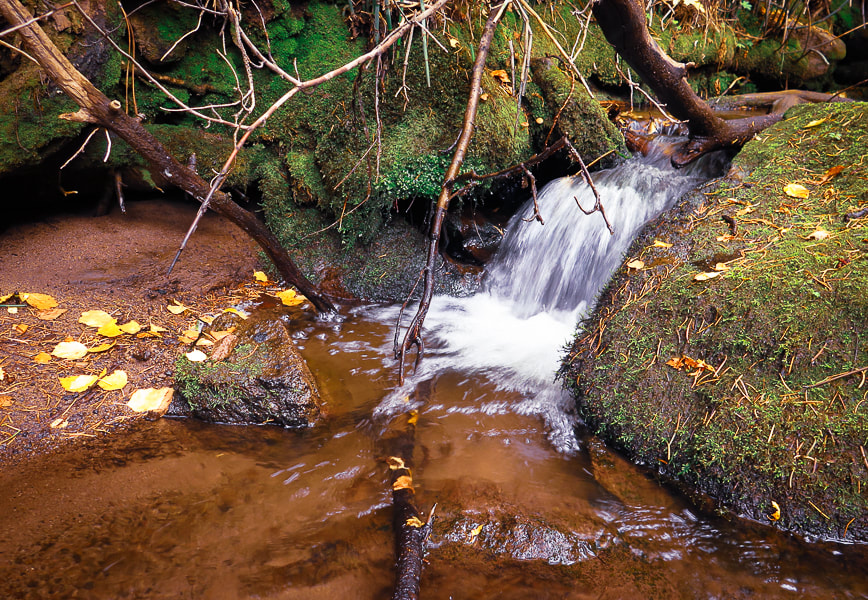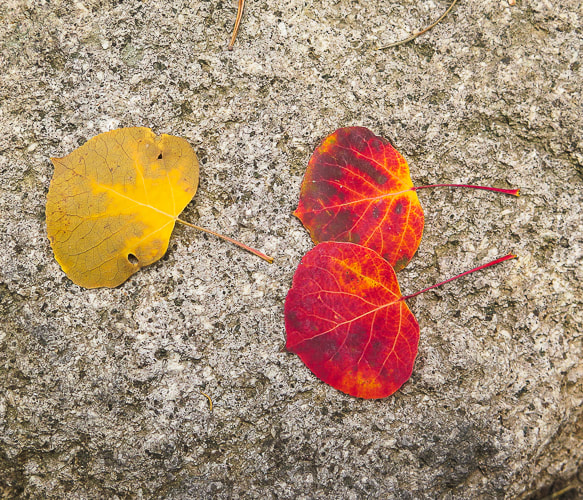|
Outstanding autumn foliage in an aspen-filled forest on a long hike to the highest summit in Utah's Pine Valley Mountains. We've still got it in us!
View south toward St. George and Red Cliffs National Conservation Area from Summit Trail in Pine Valley Mountains. Trip Stats - via Forsyth Trail Overview: Hike to the high point of Utah's fourth largest wilderness that has the most diverse flora of any other Utah range (1,000 species). You can summit Burger Peak on the way to forested Signal Peak. Start in mountain mahogany, walk along Forsyth Creek through aspens and ponderosa pines to summit of firs and pines. A spectacular view of the Red Cliffs National Conservation Area and mountains in Arizona is seen as you climb out of the forest near the base of Burger Peak. Location: Dixie National Forest, Pine Valley Mountain Wilderness, out of Pine Valley, north of St. George, Utah. Distance/Elevation gain: 14 miles out and back/3,900' cumulative gain. Trailhead = 6,650', Summit = 10,369'. Difficulty: Moderate - Strenuous on Class 1 to base of Signal Peak; Class 2 to summit (no trail). Prominence: 4,485'. Coordinates: Forsyth Trailhead = 37.38331 -113.50682. Signal Peak: 37.3197, -113.49162. Trails: Forsyth Trail (#31012) to Summit Trail (#31021). Maps and Apps: Trails Illustrated #715 - St. George-Pine Valley Mountains, Garmin GPS, Avenza (St. George/Springdale/Hurricane map). Date Hiked: 10/7/22 History: Pine Valley was discovered by Mormon pioneers Gunlock Bill Hamblin, Jacob Hamblin, and Isaac Riddle when they were moving cattle north of Santa Clara for summer grazing. A sawmill to process lumber was erected in 1856. The tall white Pine Valley Chapel stands out as you drive through town. Built in 1868 according to Ebenezer Bryce's plan, it is the oldest meetinghouse in continuous use of the Church of Jesus Christ of Latter Day Saints. Bryce reportedly followed a lost cow later into a beautiful canyon - the now famous Bryce Canyon National Park. Bryce's experience in Scotland as a shipbuilder was the impetus for the well-constructed chapel. Geology: The Pine Valley Mountain range is the largest laccolith in the U.S., and perhaps the world. Molten rock was injected into existing strata 20 million years ago; top layers eroded to reveal this large body of monzonite rock (similar to granite). This monzonite porphyry (coarse-grained) rock was deposited over the famous Claron formation, the rock that is seen in the form of hoodoos in Bryce Canyon. Our Hike If you ever happen to be in southwestern Utah the first week of October, I highly recommend this hike. The onset of autumn makes an enchanting forest in the Pine Valley Mountains; it reminds me of the spectacular autumn foliage we saw when we lived in New Hampshire. In my last post, I indicated that most people aren't aware of the hidden, magical world of southern Utah's Ashdown Gorge beneath the highway out of Cedar City. It's the same with the steep and rugged Pine Valley Mountain Wilderness just north of St. George. In this case, you can see this "sky island" rising like a hulk over red sandstone and black cinder cones, but it's not until you actually get into the heart of this wilderness that you realize its extraordinary beauty and find solitude. We timed our hike to the highest point in the Pine Valley Mountains - Signal Peak - perfectly. The autumn colors were at their optimum, adding variety and depth to this dense forest. We had already summited Burger Peak, the second-highest in this beautiful, lightly-traveled mountain range, navigating deep snow banks in the spring. Lucky for me, afternoon clouds provided the best light that made these colors glow, so I spent a lot of time yelling ahead to Fred that I had stopped to photograph. We saw only three other hikers who were also enjoying the "zen" of this enchanting forest. We are frequent visitors to this range that is remarkable for having the most botanical species than any other Utah mountain range - including three new species to Utah recently identified. We hiked Gardner Peak, a summit not often traveled a few months ago with friends. Striking rock formations growing gnarly old trees form steep cliffs with almost vertical valleys that drop toward the south when you finally emerge from the forest for a huge view of Southern Arizona and the red and yellow rocks near St. George at about 10,000 feet elevation. It's a brief view near the base of Burger Peak, and then it's back into the forest for the one-mile walk to Signal Peak summit. The spur trail to Burger Peak, ~ one mile before Signal Peak, is marked by an easy-to-miss two-rocked duck.
Scramble from Summit Trail to Signal Peak Summit We found Summit Trail to be well-marked with cairns and tree blazes. I took a waypoint on my Garmin as we left the Summit Trail to make sure we would catch it again on the descent. There is no marked trail to the summit. If you pay attention on your descent from Signal, you will see Summit Trail, but it may not be obvious. I used Avenza app to find the summit. The peak is forested, so there's no great view.
Mountain Mahogany lines the first mile of the Forsyth Trail. Ascending Forsyth Canyon - these cliffs are seen from the town of Pine Valley. Forsyth Creek Almost at Pine Valley Wilderness boundary. Some cool stuff on the trail. Rocks of Pine Valley Mountain range are monzonite porphyry, a coarse-grained intrusive rock from molten lava. It is deposited over the Claron Formation, the rock famous for hoodoos in Bryce Canyon National Park. Tree blazes on the lightly-traveled Summit Trail that links Pine Valley Mountain range's highest peaks. Large stands of Engelmann spruce exist on the southern portion of the Pine Valley Wilderness, near Signal Peak. The beautiful monzonite porphyry! - Oh, and the lava flows and red rocks to the south near St. George. Views from Summit Trail between Burger and Signal Peaks. The rock cairn that marks summit of Signal Peak. I could not find a peak register. Near the highest elevation of the Pine Valley Mountains looking west at patterns of clouds/sun changing light on the landscape. Temperature perfect. Light perfect. Beauty surrounding the trail. Wish I could stay longer! A look at my next post: Adventures in Kanab. Peakaboo slot canyon Our GPS tracks to Burger Peak (previously in blue), as it becomes Summit Trail after intersection with Blake-Gubler Trail. Our tracks to Signal Peak, highest elevation in Pine Valley Mountains are in red. Click for larger image Our GPS tracks for the previous Burger Peak hike on Forsyth Trail. Forsyth trailhead on top of map (north). Signal Peak is located on bottom of map. For Google Earth view of our tracks, click Burger Peak post. References
Miller, Rick. Our Geological Wonderland: The Pine Valley Mountain Laccolith. The Independent.
2 Comments
11/10/2022 12:57:48 pm
My god, what stunning photographs! I love the monzonite porphyry marking the view of St. George. Such striking rock formations. And I also love how you captured the light on the cliffs ascending Forsyth Canyon. The foliage shots are breathtaking. You guys are masters of finding the path less traveled, thanks to the wilderness areas that are not so inviting to the less intrepid human visitors.
Reply
Linda! I didn't know you were dealing with cancer! I looked on your site but could not find a mention of it unless I am not looking in the right place. Well, it sounds like you are beating it and I sincerely hope you are!
Reply
Leave a Reply. |
Categories
All
About this blogExploration documentaries – "explorumentaries" list trip stats and highlights of each hike or bike ride, often with some interesting history or geology. Years ago, I wrote these for friends and family to let them know what my husband, Fred and I were up to on weekends, and also to showcase the incredible land of the west.
To Subscribe to Explorumentary adventure blog and receive new posts by email:Happy Summer!
About the Author
|











































